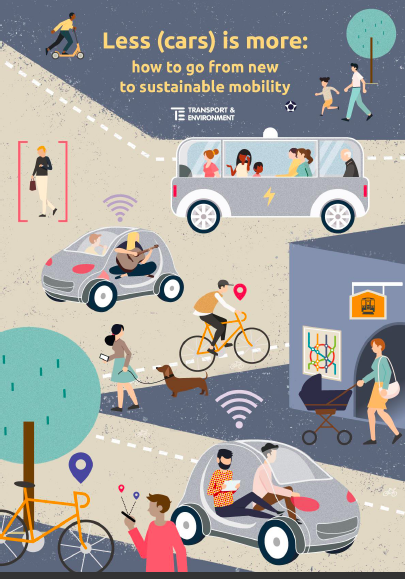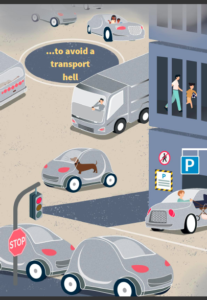New Study by Transport & Environment
All the chatter about transport, especially by car for personal or business purposes, focuses on rapidly developing technological developments, especially autonomous, electric and shared rides. These advances are seen as transformative, and appeal to our hopes (dreams? fantasies?) that some new machines or software will solve the problem with increasing greenhouse gas (GHG) emissions from the transport sector. While sun and wind are increasingly replacing fossil fuels for generating electricity, there are fewer alternative fuels for our cars, or trucks or buses or airplanes.
In a recent study, Less (cars) is more: how to go from new to sustainable mobility, the environmental NGO Transport & Environment (T&E) has demonstrated that such tech fixes are necessary but insufficient. We also need zero emission transport and less congestion, and these add-ons will require thoughtful and coordinated policies, especially in urban planning. It is in these areas where the rubber metaphorically hits the road.

The technology that has the potential to transform the transport sector is known and developing, some of it driven by Artificial Intelligence (AI). It provides for autonomous driving, with no human driver of the vehicle; shared driving, with more than one person sharing rides in vehicles; and electric rather than internal combustion engines. Some of these tech fixes are further along than others, but the expectations for each are high. T&E discusses each in its report.
While the direction and potential scope of the tech fixes are clarifying, T&E provides an assessment of the implications of these fixes once fully developed, and particularly the possible adverse consequences. T&E does note that the fixes are particularly suited to urban mobility, and that tackling rural transport challenges is far more complicated.
Implications
Some tech fixes simply aggravate the transport problem. T&E points out that many of those developing automated transport continue to support fossil fuel, internal combustion engines. There is little sense supporting policies for automated driving that extends the impacts from fossil fuel vehicles. We would end up with the same or more GHG emissions or pollution.
Similarly, app-based ride-sharing arrangements, such as Uber, can lead to more kilometers driven, increased emissions and worse congestion. If these ride-sharing arrangements become automated, without drivers, the costs of rides should drop and demand likely will increase proportionately, and congestion will expand. If ride-sharing does reduce congestion, there is the danger that the freed-up road space will attract single-occupied cars to re-enter the market.
The tech fixes can be undermined by these “rules of the road,” especially the rebound effect where fewer cars and less traffic can induce traffic to pre-sharing levels. At 34.
A central point of the T&E study is that tech fixes require accompanying policy fixes, including through urban planning. For instance, to counter any rebound effect, sharing rides should be subject to road user charges or fees on non-shared rides. Moreover, all automated vehicles must be zero emissions, such as electric vehicles with a renewable electric grid powered by wind or sun.

Broader policies are also needed, and they need to shift from an analysis based on vehicle flows to one centered on remaking spaces for people rather than cars. Policies should reduce access to road space for private cars and also to parking, and increase costs for single occupancy vehicles. At the same time, and in conjunction with these policies, cities need to design and build infrastructure for public not private transport. Let’s not forget that public buses are perhaps the most efficient and productive form of ride sharing.
One goal of developing sustainable mobility would be to reduce, significantly, parking spaces in urban areas as a means of discouraging use of private cars. At the same time, this freed-up parking space, as well as reduced road space for cars, can be turned over to space for buses, cycling and walking. Some of this space could be used for shared bikes and e-scooters to complement public transport (bus and rail) connections.
Sources:
Transport & Environment, Less (cars) is more: how to go from new to sustainable mobility (September 2019). bit.ly/2XP7Hg8


No comments yet, add your own below